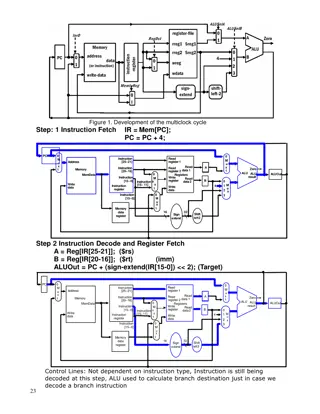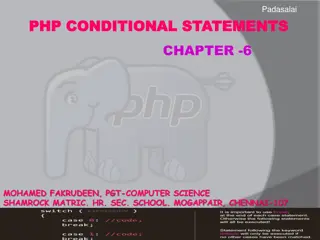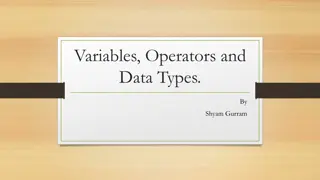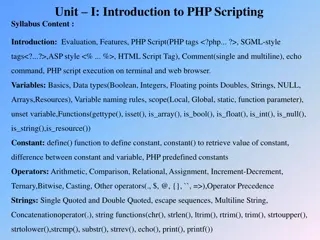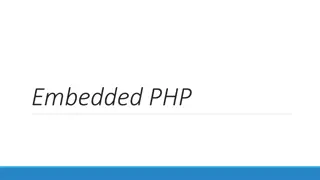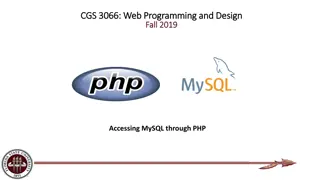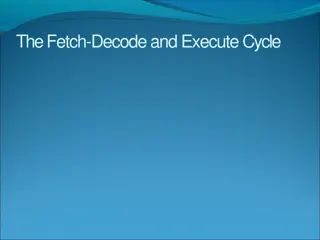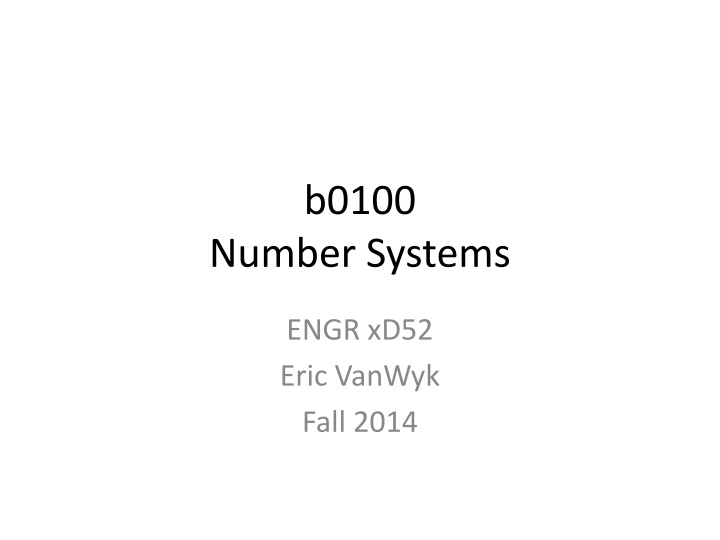
Number Systems: Radices, Conversions, and Cultural Perspectives
Explore the concepts of number systems, radices, negative numbers, and fixed points in engineering through Eric VanWyk's Fall 2014 course. Discover the significance of different bases in various cultures and how to convert between different radix systems.
Download Presentation

Please find below an Image/Link to download the presentation.
The content on the website is provided AS IS for your information and personal use only. It may not be sold, licensed, or shared on other websites without obtaining consent from the author. If you encounter any issues during the download, it is possible that the publisher has removed the file from their server.
You are allowed to download the files provided on this website for personal or commercial use, subject to the condition that they are used lawfully. All files are the property of their respective owners.
The content on the website is provided AS IS for your information and personal use only. It may not be sold, licensed, or shared on other websites without obtaining consent from the author.
E N D
Presentation Transcript
b0100 Number Systems ENGR xD52 Eric VanWyk Fall 2014
Acknowledgements Revised by George Herring Lisa Park Juliana Nazar Keely Haverstock
Today Radix R Numbers Negative Numbers Fixed Point Homework Letters: Dimitar Dimitrov, Thomas Chen
There are 10 types of people Those that understand binary Those that do not
There are 10 types of people Those that understand binary Those that do not And those who do not presume Radices
Rebasing and Reradixing 123 = 1*(10^2) + 2*(10^1) + 3*(10^0) This is true for all Radices! h123 = 1*(h10^2) + 2*(h10^1) + 3*(h10^0) 1*d16^2 + 2*d16^1 + 3*d16^0 = d291 o123 = 1*(o10^2) + 2*(o10^1) + 3*(o10^0) 1*d8^2 + 2*d8^1 + 3*d8^0 = d83
Innocence Lost You can not assume to know the base of a number without context or indication. Be Explicit.
Radices in Other Cultures Decimal is most common Base 8 Native Americans Base 20 Mayan Base 60 Babylonians Mixed 6 & 10 Base 12 Nigeria, Various Mathematicians Base 24 Kaugel (Papa New Guinnea) In groups of 4
Base 27 in Telefol Fingers (1-5) (Left hand first) Wrist, forearm, elbow, bicep, shoulder (6-10) Neck, Ear, Eye (11-13) Nose (14) Eye, Ear, Neck (15-17) Shoulder, bicep, elbow, forearm, wrist (18-22) Fingers (23-27)
Common Indicators Hexadecimal D = 0123456789ABCDEF 0x1234 h1234 123416 Octal D = 01234567 01234 o1234 12348 Decimal(10) D = 0123456789 1234 d1234 123410 Binary (Base 2) D = 01 0b1010 b1010 10102
Radix Conversion General Conversion to base N Digit = (Input) % (N) Input = (Input) / (N) Repeat until Input is exhausted (zero) writing digits right to left . Or, left to right. Digit = (Input) / (N^ position) Input = (input) Digit * (N ^ position) Picking arbitrary digits?
Easy Radix Conversion When converting between bases that are powers of each other, the division operation becomes trivial. 1 Hex digit = 4 binary digits (bits) 3 Binary digits = 1 Octal digit (octets) 1 R=r^n digit = n R=r digits Example b100111111011101011011
Easy Radix Conversion Trick b100111111011101011011 b100 111 111 011 101 011 011 o 4 7 7 3 5 3 3 To Hex b 1 0011 1111 0111 0101 1011 h 1 3 F 7 5 B
BOARDS Truth Table for Binary Adder Inputs: A, B, Carry In Output: Sum, Carry Out Multiply d29 by hf In Binary In Quaternary (R=4) In Hex Convert to Decimal b101100 hE32 Pay close attention to the carry logic When do you have to carry two places over? Try adding one more row in the ternary problem. o325 Convert 79 from Decimal to Bin, Oct, and Hex 20123 + 11123 + 2223 + 10123 = ???9
Additional Radix Carrying Food for Thought - A Radix R adder uses a single carry out digit for 11 inputs. R One of those is used by the carry in. That leaves us with 10 (R) inputs. In Binary, this is sad.
Negative Numbers Three Possible Options: Sign / Magnitude One bit denotes sign, rest denotes magnitude 1 s Complement (Inverse) Negative is the inverse of Positive 2 s Complement Negative is the complement w.r.t. R^N (2^N)
Negative Numbers Three Possible Options: Sign / Magnitude One bit denotes sign, rest denotes magnitude (R-1) s Complement (Inverse) Negative and Positive add to (R^N)-1 R s Complement Negative and Positive add to R^N
Rs Compliment A + -A = R^N Example: R = 10, N=1, Calculate 6+(-3)=3 Find Representation for -3: R^N A = -A 10^1 3 = 7 Calculate with addition: 6+7 = 13 Truncate to N=1 13 3 Adding 7 is like subtracting 3, but carry magic. Truncation is the key What is -3 in R=10, N=3?
2s Compliment Shortcut: Invert, add 1. -1 +0 +1 -2 1111 0000 1110 2: 2: 2 + 1: b1110 -2: 0001 b0010 b1101 -3 +2 1101 0010 -4 +3 1100 0011 -5 1011 +4 0100 1010 0101 -6 +5 b1110 1001 0110 +6 -7 1000 0111 +7 -8 Note: Extra negative number!
Addition in Twos Complement 0 0 1 0 (+2) + 0 1 0 0 (+4) 1 1 1 0 (-2) + 1 1 0 0 (-4) 0 0 1 0 (+2) + 1 1 0 0 ( -4) 1 1 1 0 ( -2) + 0 1 0 0 (+4)
Addition in Twos Complement 0 0 1 0 (+2) + 0 1 0 0 (+4) 0 1 1 0 1 1 1 1 1 0 (-2) + 1 1 0 0 (-4) (1) 1 0 1 0 1 1 0 0 1 0 (+2) + 1 1 0 0 ( -4) 1 1 1 0 1 1 1 0 ( -2) + 0 1 0 0 (+4) (1) 0 0 1 0
Subtraction in Twos Complement A - B = A + (-B) = A + B + 1 -1 +0 0010 - 0110 +1 -2 1111 0000 1110 0001 -3 +2 1101 0010 -4 +3 1100 0011 1011 - 1001 -5 1011 +4 0100 1010 0101 -6 +5 1001 0110 +6 -7 1000 0111 1011 - 0001 +7 -8
Sign Extension in Rs Compliment Positive numbers Left pad with 0 Negative Numbers Left Pad with (R-1)s 2 s Compliment Left Duplicate the most significant (sign) bit.
Overflows in Twos Complement Add two positive numbers to get a negative number or two negative numbers to get a positive number -1 -1 +0 +0 -2 -2 1111 +1 0000 1111 +1 0000 1110 1110 0001 0001 -3 -3 +2 +2 1101 1101 0010 0010 -4 -4 +3 1100 +3 1100 0011 0011 -5 -5 1011 1011 0100 +4 0100 +4 1010 1010 -6 -6 0101 0101 +5 +5 1001 1001 0110 0110 -7 -7 +6 +6 1000 0111 1000 0111 -8 -8 +7 +7 -7 - 2 = +7 5 + 3 = -8 24
Overflow Detection in 2s Complement 0 1 0 1 5 1 0 0 1 -7 0 0 1 1 3 1 1 1 0 -2 -8 7 Overflow Overflow 5 0 1 0 1 -3 1 1 0 1 2 0 0 1 0 -5 1 0 1 1 7 -8 No overflow No overflow Overflow when carry in to the most significant column does not equal carry out
Fixed Point Numbers Integer scaled by a fixed factor. Fixed number of digits before and after the radix point. b0101.1100 = 2^2 + 2^0 + 2^-1 + 2^-2 = 5.75 IQ Notation I8Q24 U16Q16 Signed, 8 bits before, 24 bits after Unsigned, 16 before, 16 after
MOAR BOARDS For Each: What IQ should you use? Convert to binary IQ Do the math in binary Maintaining decimal place Fixing it later 3.375 1.5 4.125 * 2.25 3 * -0.5
Notes for MP0 Teams of 3 or 4 Your choice of team mates Yes, across sections Pairs of teams will share an FPGA





